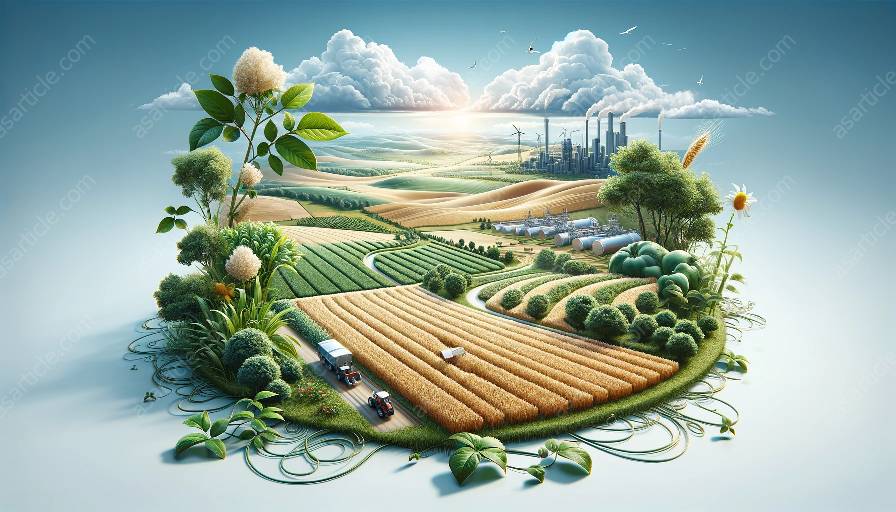In the world of agriculture, the value chain represents the intricate process of production, distribution, and consumption of agricultural products. This interconnected system involves several stages, including planting, harvesting, processing, packaging, marketing, and selling. The agricultural value chain plays a critical role in agricultural marketing and agribusiness while also being heavily influenced by advancements in agricultural sciences.
The Key Components of the Agricultural Value Chain
The agricultural value chain is a complex network that involves various stakeholders and activities. Understanding its key components is essential to recognizing its importance in agricultural marketing and agribusiness.
1. Production
The value chain begins with the production of agricultural commodities. This stage encompasses activities such as land preparation, planting, irrigation, fertilization, and pest control. Advancements in agricultural sciences, including biotechnology and precision farming, have significantly impacted production efficiency and output.
2. Processing
After harvesting, agricultural products undergo processing to make them suitable for consumption or further manufacturing. This involves activities such as cleaning, sorting, grading, and packaging. Through technological advancements, processing has become more efficient, enhancing the quality and shelf life of agricultural products.
3. Marketing
Marketing is a crucial component of the value chain that involves promotion, distribution, and sales of agricultural products. Agricultural marketing encompasses market research, branding, pricing, and advertising. Agribusinesses strategically leverage marketing techniques to create demand for their products and maximize profitability.
4. Distribution
Efficient distribution ensures the timely and cost-effective delivery of agricultural products to consumers. This stage involves transportation, warehousing, and logistics management. Innovations in transportation and logistics have enabled agribusinesses to expand their market reach and reduce supply chain inefficiencies.
5. Consumption
The ultimate purpose of the agricultural value chain is to meet consumer demand for food, feed, fiber, and fuel. Consumers play a pivotal role in shaping the value chain by influencing product preferences and purchasing behavior.
The Role of Agricultural Marketing in the Value Chain
Agricultural marketing is closely intertwined with the agricultural value chain, as it focuses on the promotion and distribution of agricultural products. It encompasses various activities, including market analysis, product positioning, and customer relationship management. Effective agricultural marketing is crucial for agribusinesses to differentiate their products, create value for customers, and build strong brand equity.
Additionally, agricultural marketing plays a pivotal role in shaping consumer perceptions and behaviors. Through targeted promotional strategies and market research, agribusinesses can effectively influence consumer preferences and enhance the demand for agricultural products.
Agribusiness and the Agricultural Value Chain
Agribusinesses are entities involved in various agricultural activities, including production, processing, and distribution. They play a central role in the agricultural value chain by contributing to its efficiency and sustainability. Agribusinesses integrate agricultural sciences, technological innovations, and marketing strategies to optimize their operations and meet market demands.
The integration of agricultural sciences in agribusiness operations has led to significant advancements in production techniques, product development, and sustainability practices. Agribusinesses leverage scientific research and technological innovations to improve crop yields, reduce environmental impact, and develop innovative agricultural products.
Impact of Agricultural Sciences on the Value Chain
Agricultural sciences encompass disciplines such as agronomy, horticulture, soil science, and genetic engineering, among others. These sciences play a vital role in driving innovation and progress within the agricultural value chain. Advancements in agricultural sciences have revolutionized production methods, improved product quality, and enhanced environmental sustainability.
Furthermore, agricultural sciences have facilitated the development of specialized agricultural products and genetic modifications that have transformed the industry. Biotechnology, genetic engineering, and precision agriculture are among the innovative fields that have significantly impacted the agricultural value chain, providing opportunities for agribusinesses to diversify their product offerings and improve supply chain efficiencies.
The Global Impact of the Agricultural Value Chain
The agricultural value chain has far-reaching global implications, influencing food security, economic development, and environmental sustainability. By linking agricultural marketing, agribusiness, and agricultural sciences, the value chain contributes to the diversification of agricultural products, the optimization of resource utilization, and the creation of employment opportunities.
Moreover, the interconnectedness of the value chain allows for knowledge transfer and technology diffusion across regions, fostering collaboration and innovation on a global scale. This collaborative approach is essential for addressing global challenges such as food scarcity, climate change, and sustainable agricultural development.
Conclusion
The agricultural value chain represents a dynamic and interdependent system that forms the backbone of the agricultural industry. By understanding the critical linkages between agricultural marketing, agribusiness, and agricultural sciences, stakeholders can leverage this knowledge to drive innovation, improve efficiency, and create sustainable agricultural practices. Embracing the interdisciplinary nature of the agricultural value chain is essential for shaping the future of agriculture and ensuring a resilient global food supply.

